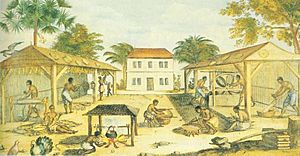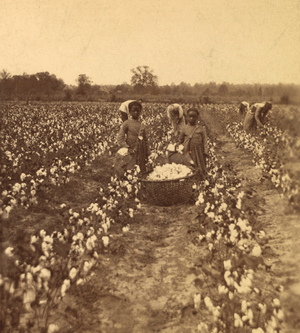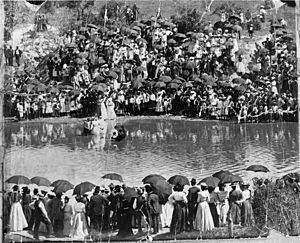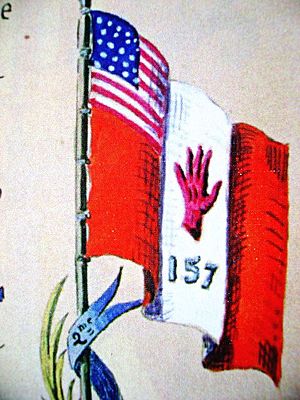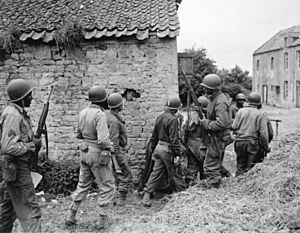African American history facts for kids

African-American history is the story of Black people in the United States. Most African Americans are descendants of Africans brought to the U.S. as captives between 1619 and 1865. People of Black Caribbean descent who moved to the U.S. are also often called African American. They share a history of West or Central African roots, the difficult Middle Passage journey, and slavery.
This history is celebrated every year in February during Black History Month. This article focuses on their journey and experiences.
Contents
- African Origins
- Introduction of Slavery
- The Revolution and Early America
- The Antebellum Period
- The American Civil War
- Emancipation and Reconstruction
- Jim Crow, Disfranchisement, and Challenges
- Civil Rights
- The Great Migration and the Harlem Renaissance
- World War I
- World War II
- Second Great Migration
- The Civil Rights Movement
- Post Civil Rights Era African-American History
- Images for kids
African Origins
Most African Americans come from enslaved people. Many were sold into slavery by African states after being captured in wars. Others were kidnapped by slave traders from Africa, Arabia, Europe, or America. Europeans used this existing slave trade to get free labor for their New World plantations.
The enslaved people in America came from many different groups in Western and Central Africa. These included the Bakongo, Igbo, Mandé, Wolof, Akan, Fon, and Makua. Over time, these groups blended their cultures. They created a new history and culture in the Americas.
Africans were taken from these regions during the Atlantic slave trade:
- Senegambia: From the Senegal River to the Casamance River. Captives from the Upper and Middle Niger River Valley were also sold here.
- Sierra Leone region: From the Casamance to the Assini River. This area includes modern Guinea-Bissau, Guinea, Sierra Leone, Liberia, and Côte d'Ivoire.
- Gold Coast region: Mostly modern Ghana.
- Bight of Benin region: From the Volta River to the Benue River. This includes modern Togo, Benin, and southwestern Nigeria.
- Bight of Biafra: From southeastern Nigeria through Cameroon into Gabon.
- West Central Africa: The largest region, including the Congo and Angola.
- Mozambique-Madagascar: Modern Mozambique, parts of Tanzania, and Madagascar.
Here's where African Americans brought to British North America and Louisiana came from (1700–1820):
| Region | Percentage |
|---|---|
| West Central Africa | 26.1% |
| Bight of Biafra | 24.4% |
| Sierra Leone | 15.8% |
| Senegambia | 14.5% |
| Gold Coast | 13.1% |
| Bight of Benin | 4.3% |
| Mozambique-Madagascar | 1.8% |
Introduction of Slavery
The first Africans arrived in Jamestown, Virginia in 1619. A Dutch ship sold 19 Black people as indentured servants. This meant they worked for a set number of years and then were freed. Over time, this practice changed. It was replaced by a system of slavery based on race, similar to what was used in the Caribbean.
Massachusetts was the first colony to make slavery legal in 1641. Other colonies soon followed. They passed laws that made children of enslaved mothers also enslaved for life. They also made non-Christian imported servants enslaved for life.
About 10 to 12 million Africans were brought to the Western Hemisphere. Most came from West Africa. Only about 3% (300,000) went to the American colonies. The rest went to the West Indies, where many died quickly. In the American colonies, conditions were better. There was less disease, more food, some medical care, and lighter work.
At first, white indentured servants outnumbered Africans in the South. But plantation owners needed more workers. They turned to lifetime slavery because enslaved people worked for no wages and could not easily escape.
Enslaved people often created their own family systems, religions, and customs. Owners usually didn't interfere, as long as the work got done.
By 1700, there were 25,000 enslaved people in the American colonies. This was about 10% of the population. Their legal status was clear: they and their children were enslaved for life. They could be sold or freed. A small number managed to escape.
A group of free Black people slowly grew. They lived mostly in port cities along the Atlantic coast. Enslaved people in cities had more freedoms. But most lived on southern tobacco or rice plantations. They usually lived in groups of 20 or more.
The most serious slave rebellion was the Stono Uprising in September 1739 in South Carolina. About 150 enslaved people rose up. They took guns, killed twenty white people, and headed for Spanish Florida. The local militia quickly stopped them and killed most of them.
All American colonies had slavery. In the North, enslaved people were often personal servants (2% of the population). In the South, they were mostly field hands on plantations (25% of the population).
The Revolution and Early America
The late 1700s were a time of big political change in the United States. People were demanding freedom from British rule. Some pointed out that slave owners demanding freedom was unfair. The Declaration of Independence was written by Thomas Jefferson, who owned over 200 enslaved people. Other Southern leaders also owned many enslaved people.
The Second Continental Congress thought about freeing enslaved people to hurt British trade. They removed parts of the Declaration of Independence that criticized King George III for promoting slavery. Free Black people, like Prince Hall, asked for slavery to end. But these requests were mostly ignored.
Despite this, Black people, both free and enslaved, joined the Revolution. Crispus Attucks, a free Black tradesman, was the first person killed in the Boston Massacre. This event led to the American Revolutionary War. About 5,000 Black people, including Prince Hall, fought in the Continental Army. Many fought alongside white soldiers at the battles of Lexington and Concord and Bunker Hill. But in 1775, George Washington stopped recruiting Black soldiers.
The British and Loyalists offered freedom to any enslaved person owned by a Patriot who joined their forces. Lord Dunmore, the Governor of Virginia, quickly recruited 300 African American men into his Ethiopian regiment. In South Carolina, 25,000 enslaved people, more than a quarter of the total, escaped to join the British or flee for freedom during the war. Thousands also escaped in Georgia, Virginia, New England, and New York. Famous Black Loyalist soldiers included Colonel Tye and Boston King.
The Americans won the war. In the peace treaty, they asked for their "property," including enslaved people, to be returned. However, the British helped up to 4,000 documented African Americans leave the country. They went to Nova Scotia, Jamaica, and Britain, rather than returning to slavery.
The Constitutional Convention of 1787 created the government for the new United States. The Constitution talked about freedom and equality. But it also allowed slavery to continue through the fugitive slave clause and the three-fifths compromise.
Also, free Black people's rights were limited in many places. Most could not vote and were not allowed in public schools. Some Black people fought these issues in court. In 1780, Elizabeth Freeman and Quock Walker used language from the new Massachusetts constitution. It said all men were born free and equal. They used this in freedom suits to gain their release from slavery. A free Black businessman in Boston, Paul Cuffe, tried to avoid paying taxes since he had no voting rights.
In the Northern states, the spirit of the Revolution helped African Americans. Many people felt that slavery was bad for the country and should be ended. All Northern states passed laws to end slavery between 1780 and 1804. Most of these laws ended slavery slowly.
In 1787, Congress passed the Northwest Ordinance. This law banned slavery in the large Northwest Territory. By 1790, there were over 59,000 free Black people in the United States. By 1810, this number grew to 186,446. Most were in the North. But the Revolution also inspired some Southern slaveholders.
For 20 years after the Revolution, more Southerners freed enslaved people. Sometimes they did this by choice or in their wills after they died. In the Upper South, the number of free Black people grew from about 1% before the Revolution to over 10% by 1810. Quakers and Moravians worked to convince slaveholders to free families. In Virginia, the number of free Black people increased from 10,000 in 1790 to almost 30,000 in 1810. But 95% of Black people were still enslaved. In Delaware, three-quarters of all Black people were free by 1810. By 1860, over 91% of Black people in Delaware were free, and 49.1% in Maryland.
One successful free man was Benjamin Banneker. He was a Maryland astronomer, mathematician, and surveyor. In 1791, he helped map the boundaries of the future District of Columbia. Despite the challenges, most free Black people were better off than the nearly 800,000 enslaved Black people. Still, many thought about moving to Africa.
The Antebellum Period
As the United States grew, slavery became stronger in the southern states. Meanwhile, northern states began to end it. Pennsylvania was the first, passing a law for gradual abolition in 1780.
Several events changed views on slavery. The invention of the cotton gin in 1793 made it easier to grow cotton. This led to a huge demand for enslaved labor to work on new cotton plantations. The number of enslaved people in the United States increased by 70% in just 20 years. Most of them were in the Deep South.
In 1808, Congress banned the international slave trade. This was a victory for Black Americans fighting slavery. But it also increased the demand for enslaved people already in the country. In the Upper South, farming changed from tobacco to other crops, needing less labor. So, enslaved people were sold to traders for the growing Deep South.
Also, the Fugitive Slave Act of 1793 allowed any Black person to be claimed as a runaway. They could only be saved if a white person spoke for them. Many free Black people, especially children, were kidnapped and sold into slavery. By 1819, there were 11 free states and 11 slave states. This caused more division between North and South. Fears of an imbalance in Congress led to the 1820 Missouri Compromise. This law required states to join the union in pairs, one slave and one free.
Over 1 million enslaved people were moved from older slave states to the rich cotton states of the southwest. Many others were sold and moved within their local areas.
The Black Community
The number of free Black people also grew. By 1830, there were 319,000 free Black people in the United States. 150,000 lived in the northern states. Most free Black people were poor. But some started successful businesses that served the Black community.
Racial discrimination often meant Black people were not welcome in white businesses. To fight this, Black people built their own communities. They had Black-owned businesses, doctors, lawyers, and other professionals. These people formed the foundation of the Black middle class.
Black people also organized to strengthen their communities and fight slavery. One group was the American Society of Free Persons of Colour, founded in 1830. These groups helped poor Black people and responded to political issues. The Black community also started schools for Black children, as they were often not allowed in public schools.
The Black church was also very important. Starting in the early 1790s with the African Methodist Episcopal Church and others, Black churches became central to the Black community. They were a place for community and unique African-American spirituality. They also were a response to discrimination. At first, Black preachers formed separate groups within existing churches. But because of discrimination, some Black people started their own Black church groups.
Free Black people also started Black churches in the South before 1800. After the First Great Awakening, many Black people joined the Baptist Church. This church allowed them to participate, even as elders and preachers. By 1860, Petersburg, an industrial city, had 3,224 free Black people, the largest group in the South. In Virginia, free Black people also created communities in Richmond, Virginia and other towns. They worked as artisans and started businesses. Others bought land and farmed in frontier areas, further from white control.
The American Civil War
Emancipation and Reconstruction
In 1863, during the American Civil War (1861–1865), President Abraham Lincoln issued the Emancipation Proclamation. This freed enslaved people in the Southern states that were fighting the North. The 13th Amendment to the U.S. Constitution, approved in 1865, officially ended slavery in the United States. In 1868, the 14th Amendment gave full U.S. citizenship to African Americans. The 15th Amendment, approved in 1870, gave Black men the right to vote.
After the Union won the war, a short period of progress for Black Southerners began. This was called Reconstruction. From 1865 to 1877, with protection from Union troops, African Americans made progress toward equal rights. Black men in the South began to vote. Some were elected to the United States Congress and to local jobs like sheriff. Groups of white and Black Republicans created the first public school systems in most Southern states. Black people also started their own churches, towns, and businesses. Tens of thousands moved to Mississippi. They wanted the chance to clear land and own it themselves. By the end of the century, two-thirds of the farmers who owned land in the Mississippi Delta were Black.
The end of the Civil War sped up the process of African Americans forming a national identity. Tens of thousands of Black Northerners moved to the South. They built schools, printed newspapers, and opened businesses.
Jim Crow, Disfranchisement, and Challenges
The Jim Crow laws were state and local laws in the United States. They were passed between 1876 and 1965. These laws forced segregation in all public places. They claimed to offer "separate but equal" status for Black Americans. But in reality, facilities for Black people were usually worse than those for white people. This caused many economic, educational, and social problems.
Over the years, violence and threats against Black people grew. The U.S. government stopped protecting the rights of freedmen and women. In 1877, President Rutherford B. Hayes removed Union troops from the South. This was part of a national agreement about the election. White Southern Democrats quickly worked to undo the progress of Reconstruction. To reduce Black voting and regain control of state governments, Democrats used violence, cheating, and threats. Groups like the White League and Red Shirts were active before the 1876 elections. For example, one historian estimated that 150 Black people were killed in South Carolina in the weeks before that election. Massacres happened at Hamburg and Ellenton.
White violence against African Americans increased. Many Black people were scared. Men like Benjamin "Pap" Singleton began talking about leaving the South. This led to the Exodusters movement in 1879-1880. They moved to Kansas.

White Democrats first passed laws to make voter registration and elections harder. Most of these rules hurt Black people the most. But many poor white people also lost their right to vote. Black voting in rural areas and small towns dropped sharply.
From 1890 to 1908, ten of eleven Southern states adopted new constitutions or changes. These laws effectively stopped most Black people and many poor white people from voting. They used things like poll taxes, residency rules, and literacy tests. States greatly reduced Black voter registration and turnout, sometimes to zero.
To put Black people back in a lower status, white supremacists brought back old barriers and made new laws. They separated society by race. They limited Black access to transportation, schools, restaurants, and other public places. White supremacists also spread the idea that Black people failed in government because they were not capable. This idea was taught in school textbooks and movies like The Birth of a Nation in 1915. Even though slavery was over, most Southern Black people struggled with poverty for decades. They worked as farm laborers, house servants, and in other low-paying jobs. Many became sharecroppers, meaning their economic situation changed little after emancipation.
Racial Terrorism
After it started in 1867, the Ku Klux Klan became powerful for a few years. This secret group wanted to keep white people in charge. Its members wore masks and robes to hide their identities while they committed violence and destroyed property. The Klan used killings, physical violence, house burnings, and threats. The Klan's extreme actions led to laws against it. With federal enforcement, it was mostly gone by 1871.
The Jim Crow era brought a very cruel period of racial oppression in America. Between 1890 and 1940, millions of African Americans lost their right to vote, were killed, and were treated brutally.
Of the many thousands of murderers and people who watched these crimes, fewer than 50 white people were ever charged. Only four were sentenced.
Most Black people were denied their right to keep and bear arms under Jim Crow laws. This meant they could not protect themselves or their families.
Civil Rights
Because of these problems, in the summer of 1905, W. E. B. Du Bois and 28 other important African-American men met secretly in Niagara Falls, Ontario. They wrote a statement asking for an end to racial discrimination, full civil liberties for African Americans, and human brotherhood. The group they formed was called the Niagara Movement. During this time, African Americans continued to build their own communities and institutions. They started schools, churches, social welfare groups, banks, newspapers, and small businesses to serve their communities.
The Great Migration and the Harlem Renaissance
In the first half of the 20th century, the biggest internal population shift in U.S. history happened. Starting around 1910, over five million African Americans moved from the South to northern cities, the West, and the Midwest. They hoped to escape discrimination, violence, and find better jobs. They also wanted to vote and get better education for their children. This movement was called the Great Migration.
In the 1920s, many Black people lived in New York. This led to a cultural movement called the Harlem Renaissance. Its influence spread across the country. Black thinkers and artists were inspired by people like Aimé Césaire and Léopold Sédar Senghor, who celebrated Black identity. Arts and literature thrived. Writers like Zora Neale Hurston, Langston Hughes, Nella Larsen, Claude McKay, and Richard Wright became famous. Artists like Lois Mailou Jones, William H. Johnson, Romare Bearden, Jacob Lawrence, and Archibald Motley also gained recognition.
The South Side of Chicago became a major Black cultural center. Many people from Mississippi, Arkansas, and Louisiana moved there. It developed thriving businesses, music, arts, and food. A new generation of powerful African American political leaders and organizations also emerged.
World War I
The U.S. armed forces were still segregated during World War I. Still, many African Americans eagerly volunteered to join the Allied cause. Over two million African American men signed up for the draft. By the end of the war in November 1918, over 350,000 African Americans had served with the American Expeditionary Force in Europe.
Most African American units were given support roles and did not fight in combat. However, African Americans still played a role in America's war effort.
Four African American regiments were placed with French units. The French had lost many soldiers and needed men badly after three years of war.
One of the most famous units was the 369th Infantry Regiment, known as the "Harlem Hellfighters." They were on the front lines for six months, longer than any other American unit. 171 members of the 369th received the Legion of Merit award.
The 371st and 372nd African American Regiments were part of the 157th Red Hand Division. This division was led by French General Mariano Goybet. These regiments earned fame in the final offensive in the Champagne region of France. Both regiments were awarded the French Croix de Guerre for their bravery in the Meuse-Argonne Offensive.
Corporal Freddie Stowers of the 371st Infantry Regiment was given a Medal of Honor after his death. He was the only African American to receive this honor for actions in World War I. In France, Stowers led an attack on German trenches. He kept leading and encouraging his men even after being wounded twice. Stowers died from his wounds. But his men continued fighting a German machine gun nest and defeated the German troops.
Stowers was recommended for the Medal of Honor soon after his death. But the Army said the recommendation was lost. Many believed it was ignored on purpose due to racism in the military. In 1990, Congress pushed for an investigation. Based on its findings, the Army approved the Medal of Honor for Stowers. On April 24, 1991, 73 years after he was killed, Stowers' two surviving sisters received the Medal of Honor from President George H. W. Bush at the White House.
World War II
Military
Over 1.5 million Black people served in the military during World War II. They served in separate units.
Famous segregated units, like the Tuskegee Airmen and the U.S. 761st Tank Battalion, proved their bravery in combat. About 75% of the soldiers who worked as truckers for the Red Ball Express in Europe were African American. They kept Allied supply lines open. A total of 708 African Americans were killed in combat during World War II.
The excellent service of these units helped President Harry S. Truman decide to end discrimination in the Armed Forces. He issued Executive Order 9981 in July 1948. This led to the integration of the Air Force and other military branches by the early 1950s.
Civilian Life
Many Black people moved from poor Southern farms to cities with war factories. Racial tensions were high in crowded cities like Chicago. Detroit and Harlem had race riots in 1943. Politically, Black people left the Republican Party. They joined President Franklin D. Roosevelt's Democratic New Deal Coalition, as they admired him.
Black leaders, ministers, and newspaper editors started the Double V Campaign. This meant victory over German and Japanese fascism abroad, and victory over discrimination at home. Black newspapers created this campaign to boost morale and prevent extreme actions.
Most Black women had been farm laborers or house servants before the war. Despite discrimination, they left the cotton fields. They took factory jobs in the cities.
Second Great Migration
The Second Great Migration was when over 5 million African Americans moved from the South to other parts of the United States. It happened from 1941, through World War II, and lasted until 1970. This movement was much larger and different from the first Great Migration (1910–1940).
In the Second Great Migration, more than five million African Americans moved to cities in the North, Midwest, and West. Many went to California, where Los Angeles and Oakland offered many skilled jobs in the defense industry. More of these migrants were already city workers from the South. They were better educated and had better skills than people who did not move.
Many African Americans in the South already lived in cities. They had city job skills before they moved. They moved to take jobs in the growing industrial cities. They especially took many jobs in the defense industry during World War II (WWII). Workers who were limited to segregated, low-skilled jobs in Southern cities could get highly skilled, well-paid jobs at California shipyards.
By the end of the Second Great Migration, African Americans mostly lived in cities. Over 80% lived in cities. Fifty-three percent stayed in the Southern United States. Forty percent lived in the Northeast and North Central states. Seven percent lived in the West.
The Civil Rights Movement
The Supreme Court made a very important decision in the case of Brown v. Board of Education (1954) of Topeka. This decision led to the end of legal segregation in all parts of Southern life. This included schools, restaurants, and public restrooms. But it happened slowly and only after strong efforts by African Americans.

Perhaps the most important event of the Civil Rights Movement was the 1963 March on Washington for Jobs and Freedom. Over 250,000 people marched to the Lincoln Memorial and the National Mall in Washington, D.C.. They spoke out against Southern racial violence and police brutality. They also demanded equal job opportunities and equal access to education and public places.
The march was organized by the "Big Seven" of the Civil Rights Movement:
- Bayard Rustin, the strategist.
- A. Phillip Randolph, who started the march.
- Roy Wilkins of the NAACP.
- Whitney Young, Jr. of the National Urban League.
- Martin Luther King, Jr. of the Southern Christian Leadership Conference (SCLC).
- James Farmer of the Congress on Racial Equality (CORE).
- John Lewis of the Student Non-violent Coordinating Committee (SNCC).
Dorothy Height, head of the National Council of Negro Women, was also active behind the scenes. She shared the stage with Dr. King. It was at this event that King gave his famous "I Have a Dream" speech. This march and the conditions that led to it put pressure on President John F. Kennedy and then Lyndon B. Johnson. This led to the passage of the Civil Rights Act of 1964. This law banned discrimination in public places, jobs, and labor unions.
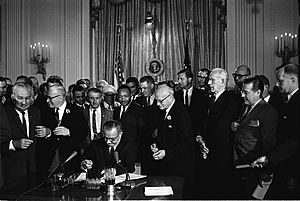
The "Mississippi Freedom Summer" of 1964 brought thousands of young people, both Black and white, to the state. They ran "freedom schools" to teach basic reading, history, and civics.
From the mid-1960s to the mid-1970s, the Black Power movement grew. It encouraged African Americans to find inspiration in Africa. It stressed Black unity rather than integration.
Post Civil Rights Era African-American History
After the Civil Rights era, Black people made big political and economic gains. Civil rights leader Jesse Jackson ran for president in 1984 and 1988. He brought huge support and influence to Black people in politics.
In 1989, Douglas Wilder became the first African-American elected governor in U.S. history. In 1992, Carol Moseley-Braun of Illinois became the first Black woman elected to the U.S. Senate. In 2000, there were 8,936 Black officeholders in the United States. This was an increase of 7,467 since 1970. In 2001, there were 484 Black mayors.
The 38 African-American members of Congress form the Congressional Black Caucus. This group works on issues important to African Americans. Black people have also been appointed to high federal offices. These include General Colin Powell, who led the U.S. Armed Forces, and later became United States Secretary of State. Condoleezza Rice also served as Secretary of State. Ron Brown was Secretary of Commerce. Thurgood Marshall and Clarence Thomas became Supreme Court justices. These appointments show the growing presence of Black people in politics.
Economic progress for Black people reaching extreme wealth has been slow. According to Forbes lists, Oprah Winfrey was the richest African American of the 20th century. She was the world's only Black billionaire in 2004, 2005, and 2006. Winfrey was also the only Black person on the Forbes 400 list almost every year since 1995. BET founder Bob Johnson was briefly a billionaire from 2001-2003. He returned to the list in 2006 but not in 2007. Winfrey is the only African American wealthy enough to be among America's 400 richest people. Black people make up 0.25% of America's richest, but 13% of the U.S. population.
In 2008, Illinois senator Barack Obama became the first Black presidential candidate from a major political party. He was elected as the 44th President of the United States on November 4, 2008. He took office on January 20, 2009.
Images for kids
-
A plantation in Louisiana.
-
Eight Tuskegee Airmen in front of a P-40 fighter aircraft
-
First and Second Great Migrations shown through changes in African American share of population in major U.S. cities, 1916–1930 and 1940–1970


